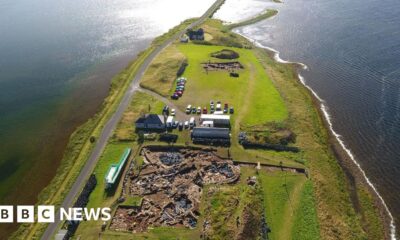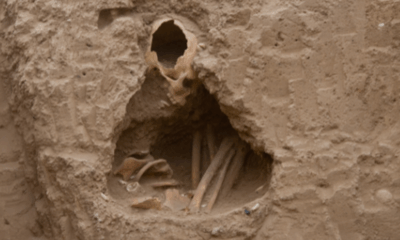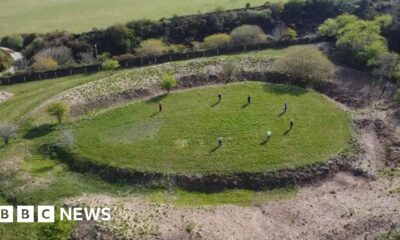Science
Archaeologists Uncover 6,000-Year-Old Cannibalism Evidence in Spain

Archaeologists in Spain have uncovered a disturbing find that sheds light on violence during the Neolithic period. While excavating the El Mirador cave, researchers discovered a collection of human bones showing clear evidence of cannibalism. These findings are detailed in a study published in the journal Scientific Reports.
The remains, dated between 5,573 and 5,709 years ago, belong to at least 11 individuals, including children. The bones exhibited signs of human bite marks, knife cuts, and fractures consistent with marrow extraction. Chemical analysis indicated that the bones had been subjected to boiling, suggesting a gruesome fate for these individuals. The researchers propose that these remains may belong to a large family who were killed and consumed in the cave, a horrific event likely linked to conflict between communities.
Insights into Neolithic Violence
According to study co-author Francesc Marginedas, an evolutionary anthropologist at the Institut Català de Paleoecologia Humana i Evolució Social (IPHES), the evidence does not point to ritualistic cannibalism or starvation. Instead, he asserts that the findings suggest a violent episode, potentially stemming from conflict among neighboring farming groups. “This was neither a funerary tradition nor a response to extreme famine,” Marginedas stated. “The evidence points to a violent episode, given how quickly it all took place.”
The analysis of the bones revealed that the victims were from the local area and likely constituted a nuclear or extended family. The ages of the individuals ranged from seven to 50 years, indicating a rapid and tragic loss of life. Researchers believe that the cannibalism observed may have been driven by conflict, rather than desperation.
Understanding Conflict-Driven Cannibalism
The discovery provides a rare glimpse into the dynamics of conflict-driven cannibalism during the Neolithic era, which is characterized by a significant evolution in human social structures. “Conflict and the development of strategies to manage and prevent it are part of human nature,” said Antonio Rodríguez-Hidalgo, another co-author of the study and an archaeologist at IPHES. He emphasized that even in less stratified societies, violent episodes can occur, leading to extreme actions such as cannibalism.
This research not only highlights a dark chapter in human history but also invites further exploration into the social dynamics of early communities. The findings from the El Mirador cave reflect the complex realities of life during the Neolithic period, where survival often hinged on the ability to navigate conflict and competition. As more discoveries emerge, they continue to challenge our understanding of human behavior and societal development during these formative years.
-

 World2 weeks ago
World2 weeks agoCoronation Street’s Shocking Murder Twist Reveals Family Secrets
-

 Entertainment1 week ago
Entertainment1 week agoAndrew Pierce Confirms Departure from ITV’s Good Morning Britain
-

 Entertainment5 months ago
Entertainment5 months agoKate Garraway Sells £2 Million Home Amid Financial Struggles
-

 Entertainment4 months ago
Entertainment4 months agoAnn Ming Reflects on ITV’s ‘I Fought the Law’ Drama
-

 Entertainment1 month ago
Entertainment1 month agoCoronation Street Fans React as Todd Faces Heartbreaking Choice
-

 Health4 months ago
Health4 months agoKatie Price Faces New Health Concerns After Cancer Symptoms Resurface
-

 World1 month ago
World1 month agoBailey Announces Heartbreaking Split from Rebecca After Reunion
-

 Entertainment2 weeks ago
Entertainment2 weeks agoTwo Stars Evicted from I’m A Celebrity Just Days Before Finale
-

 Entertainment4 months ago
Entertainment4 months agoCoronation Street’s Carl Webster Faces Trouble with New Affairs
-

 World2 weeks ago
World2 weeks agoKevin Sinfield Exceeds Fundraising Goal Ahead of Final Marathons
-

 Entertainment4 months ago
Entertainment4 months agoWhere is Tinder Swindler Simon Leviev? Latest Updates Revealed
-

 Entertainment5 months ago
Entertainment5 months agoMarkiplier Addresses AI Controversy During Livestream Response





















